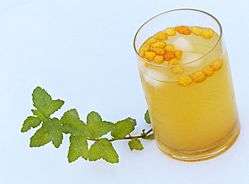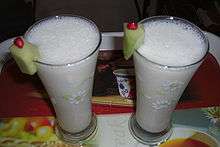List of Indian drinks
With a climate as varied and extreme as India, the people require a myriad of options to keep their thirst appropriately quenched according to the weather conditions, varying from steaming hot drinks during winters to frosty cold drinks in summers. Different regions in the country serve drinks made with an eclectic assortment of ingredients including local spices, flavors and herbs. Available on the streets, as well as on the menus of posh hotels, these drinks add to the flavorful cuisine of India.
Drinks
- Aam panna – made from raw mango
- Aamras
- Bael sharbat
- Buransh – made from rhododendron flowers with jelly like constituency, Uttarakhand
- Fruit juice
- Gaajar ka doodh-made from grated carrot and sweetened milk
- Ganne ka ras or sugarcane juice
- Gud-nimbu sharbat – made of lemon and jaggery
- Jal-jeera
- Jigarthanda, Madurai
- Kala Khatta
- Kanji
- Kesar kasturi
- Khus sharbat-made from Vetiver syrup
- Kokum sharbat
- Kulukki sharbat-Shakken Lemonade
- Liyo
- Nannaari (Sarsaparilla) sarbat – lemon-based drink, Tamil Nadu
- Nariyel Pani(Coconut water)
- Neera
- Nimbu pani (lemonade)
- Ookali – hot drink made by boiling coriander seeds, Western India
- Panakam
- Phalsa sharbat – made from Grewia asiatica
- Pudina sharbat – made from mint
- Rasam
- Rasna
- Rooh Afza
- Sakar-loung Pani – made from rock sugar and clove; famous in Gujarat, Rajasthan
- Sattu Pani – famous in North India
- Saunf paani, Gujarat
- Sharbat – drink that has many variants
- Shikanjvi
- Solkadhi
- Sugandha water
- Thandai
- Ramula -a drink made from sweet potato
Milk-based drinks
- Ambil or Ambli – prepared by using ragi flour and buttermilk, Maharashtra and Karnataka
- Buttermilk – chhachh in North India, mor in Tamil, majjiga in Telugu, majjige in Kannada, and taak in Marathi
- Falooda – a cold and sweet drink containing many ingredients, such as rose syrup, vermicelli, basil seeds, tapioca pearls, and pieces of gelatin mixed with kulfi, milk or water
- Haldi doodh or hot turmeric milk
- Lassi – a popular, traditional, yogurt-based drink from India. It is a blend of yogurt, water, spices and sometimes fruit. Traditional lassi (a.k.a., "salted lassi", or simply "lassi") is a savoury drink, sometimes flavoured with ground and roasted cumin. Sweet lassi, however, contains sugar or fruits, instead of spices. Salted mint lassi is highly favoured in Bangladesh.
- Mastaani, Pune
- Thandai
Flavoured milk
- Badam milk – almond-flavoured milk
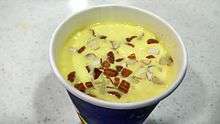 Badam milk
Badam milk - Kesar milk – saffron-flavoured milk
- Rose milk
- Sugandha milk
Tea and coffee
Coffee
- Indian filter coffee – a sweet milky coffee made from dark roasted coffee beans (70–80%) and chicory (20–30%)
- Instant coffee
Tea
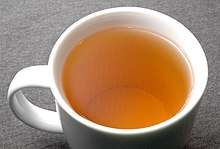
A cup of Darjeeling tea
- Assam tea
- Balma green tea
- Berinag tea
- Black tea
- Green tea
- Irani chai
- Kangra tea
- Masala chai
- Nilgiri tea
- Tulsi tea
- Milk Tea
Flavoured tea
- Butter tea
- Elaichi tea/cardamom tea
- Ginger tea
- Lemon tea
- Indian filter coffee served hot and frothy in a traditional tumbler and dabara
- Masala chai served with tea biscuits
Alcoholic drinks
Traditional
Cashew apples being squashed in Chorao, Goa, to be used in the preparation of feni
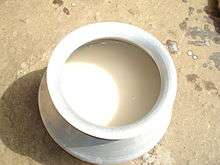
Handia is a rice beer commonly made by the indigenous people in Bihar, Jharkhand, Odisha, Madhya Pradesh and Chhattisgarh.
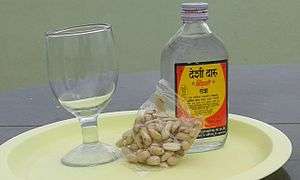
Desi daru is India's one of cheapest factory made alcoholic drinks
- Apo – traditional drink from Arunachal Pradesh made from fermented rice
- Arrack
- Bangla – an alcoholic drink made from starch and sold in West Bengal. There are government licensed counters to sell this drink. This is a distilled country liquor.
- Bhang lassi – an intoxicating drink prepared from the leaves and flowers (buds) of the female cannabis plant, consumed as a drink in the Indian subcontinent
- Bitchi – a drink consumed mostly by Garo tribals
- Bhang thandai
- Chhaang or Tongba – drink from Sikkim made from grain millet
- Cholai
- Chuak – a drink from Tripura made from rice, jackfruit and pineapple
- Desi daru
- Feni – popular in Goa
- Gudamaba – a traditional drink from Hyderabad brewed from sugar cane. It used to be produced from methane and other chemicals until the government banned it.
- Handia
- Hariya
- Kaid Um – drink in Meghalaya, consumed mostly by Khasi and Jaintia tribes
- Kallu – palm wine from Tamil Nadu
- Kodo ko jaanr – also known as chyang, prepared from finger millet[1]
- Laopani – made from fermented rice; popular in Assam
- Lugdi – made from rice, Manali
- Mahua – made from mahua flowers, Central India[2]
- Mandia pej – made from ragi powder and stale water from boiled rice, popular in Odissa
- Manri – made from fermented rice, popular in Mithila
- Pendhā
- Sekmai – from the state of Manipur; made from sticky rice.Sekmai is a name of a place, name of a community and name of a traditional alcoholic drink. It is the product of only Hamei, Rice and Water. Semai is made from Yam and Yangli (Albizia Myrophyla). Yam is made from soaked rice by grinding. Yangli is a plant which is grown on the hills of Manipur. Hamei is used as Yeast.
- Sonti
- Sulai
- Sunda Kanji – made from fermenting rice that is buried in earthen or mud pots covered with cloth, sold in Tamil Nadu
- Sura
- Thaati Kallu
- Tharra
- Toddy/Tadi/Kallu (palm wine)
- Zawlaidi – popular in Mizoram prepared from rice, millet and maize
- Zutho – from Nagaland
Non-Traditional
- Indian beer
- Indian brandy
- Indian-made foreign liquor
- Indian rum
- Indian vodka
- Indian whisky
- Indian wine
See also
References
| Wikimedia Commons has media related to Drinks from India. |
- ↑ Tamang, Jyoti Prakash (17 August 2009). "8". Himalayan Fermented Foods: Microbiology, Nutrition, and Ethnic Values. CRC Press. p. 198. Retrieved 11 August 2015.
- ↑ "Some interesting indigenous drinks among the tribals of Central India" (PDF). Indian Journal of Traditional Knowledge. 6 (1): 141–43. January 2007. Retrieved 8 February 2012.
This article is issued from
Wikipedia.
The text is licensed under Creative Commons - Attribution - Sharealike.
Additional terms may apply for the media files.


